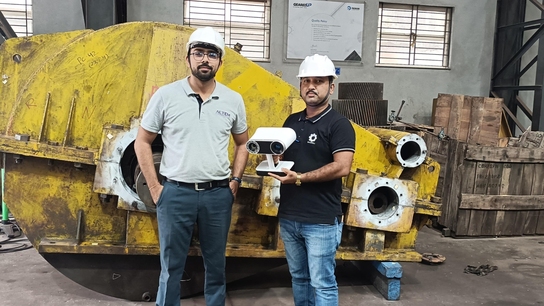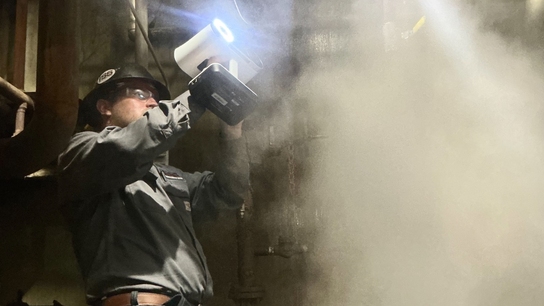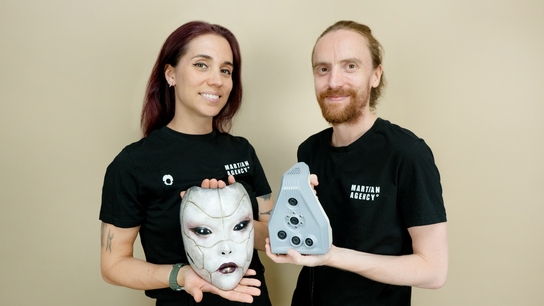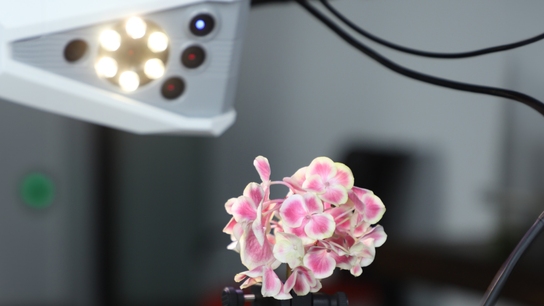Inspiring hope across Glasgow with Artec Leo
Challenge: Quickly, accurately, and easily digitize a 1.2-meter sculpture for the creation of three permanent legacy sculptures of various sizes and materials, to be installed in three locations around Glasgow for the 2021 United Nations Climate Change Conference (COP26).
Solution: Artec Leo, Artec Studio, Quicksurface CAD software
Result: Three sculptures ranging from 3.5 meters to 23 meters, around Glasgow, and made of cement-free concrete, locally sourced wood, and reclaimed metal.
Why Artec: For fast scanning in high resolution, and the ability to move around objects easily with no cables and with onboard processing, Artec Leo ensured the job was done quickly, and with excellent results.

Words from leading writers, poets, and local children are engraved into the ‘Beacon of Hope’ sculpture. Image: Keith Hunter Photography
It started as a conversation; it ended up as a gift to the people of Glasgow. That’s how Steuart Padwick, creator of The Hope Sculpture, explains it.
In 2018, Steuart Padwick’s award-winning design company made a dramatic change to the London skyline: with a sculpture of a head, emerging from the Thames River on London’s Southbank. Titled “Head Above Water,” the installation represented hope, bravery, support, and was a powerful symbol to show that we as a society do care – and the need to remove stigma from mental health.
“We both feel very strongly about removing the stigma surrounding mental health,” said project director Natalie May. “And then we’ve been touched, both of us, in all sorts of different ways – by family, and personally, and all the rest of it, but it seemed like such a brilliant place to do something impactful for it.”
Padwick and May have now worked on three major public installations including The Hope Sculpture Glasgow with Ramboll, a large, international structural engineering company. “They are incredibly passionate about the planet, social issues, equality, mental wellbeing – I mean, they’re just a phenomenally good company with a really good ethos,” May said. “So we get along really well with them, because we’re kind of very like-minded.”
“The Hope Sculpture started as a conversation with Ramboll and became a gift to Glasgow from over 50 companies. It is a testament to the power of collaboration and dedication to deliver a better future,” said Padwick.
A closer look at mental health and the environment
A couple of years later when the team at Ramboll asked what Padwick and May might be working on for COP26 – the United Nations Climate Change Conference held in Glasgow in 2021 – a new project started to develop.
“They said, would you like to do something with us – to link taking care of the environment with mental well-being,” May said. “And by building better and greener, it can improve everybody’s mental well-being quite considerably. That’s what they wanted to achieve with us.”
The pair were on board immediately. “We were very keen on doing something about the environment, about the planet, and to do something that was permanent, that wasn’t just a throwaway installation, and had a positive message,” Padwick said.
One thing that stood out to him was a conversation a Glasgow City councilor had had prior to COP26. “He’d just had a meeting with kids that were five and eight year olds, and they’re scared the planet was blowing up, scared, everyone’s going to die,” Padwick said. “And it was things like that, conversations like that, that we hadn’t heard, and that is why we wanted it to be called The Hope Sculpture.”
“Those kids shouldn’t be worrying about that. Yes, there are problems,” he said. “But there’s reasons to be excited and optimistic about the future. And we wanted to promote those.”
Spreading a message of hope
The idea was to create a sculpture that addressed three important themes: mental health, climate change, and hope for the future. Dr. Duncan Booker from Glasgow Council suggested Cuningar Loop. “It just ticked all the boxes that we wanted – it’s the biggest regeneration area in Scotland, and it is extraordinary what they’ve achieved there,” Padwick said.
The site of Cuningar Loop was once a coal mine, and then a rubbish tip, and is now a beautiful woodland park. The entire area is now part of the Clyde Gateway – Scotland’s largest regeneration project. Once the location had been decided on, the research began.
“What we hadn’t realized is that Glasgow was the engine room of the British Empire. It was huge, and it was one of the richest cities in Europe,” said Padwick. And the whole area was littered with chimneys pumping out fumes from the factories. “It had the two tallest chimneys in the world, it had the biggest chemical works, the biggest shipbuilding, the biggest steam engine works…”
But as we now know, heavy industrial work of the past brought about massive environmental pollution and changes in the climate affecting generations to come. To drive this message home, Padwick began sketching a deconstructed chimney. “And instead of the smoke, it was this child reaching out to an exciting, positive, greener future,” he added. Unlike the chimneys that came before, this new deconstructed chimney stalk is made from a new low-carbon and cement-free concrete.

Image by FourFifteen
In addition to the Cuningar Loop sculpture, Padwick designed two other sculptures: One at Glasgow Central Station (Scotland’s busiest train station with over 30 million visitors a year), and another at the University of Strathclyde. A train station has particular significance for this beacon of hope: as one of the greenest means of transport, as well as a place to connect people.
“It’s a great meeting place and a positive place with people coming back and forth,” Padwick said, “but it can often be a place that attracts people who are feeling isolated and who struggle with mental issues,” he continued. Recent research shows that Glasgow has highest rate of suicide in Scotland – a strong message of hope is now more important than ever.
How 3D scanning came into play
Using a scanner he had to capture the sculpture – the original child is made of plaster and stands at 1.2 meters tall – Padwick was met with unsatisfying results and a poor mesh. Besides producing low-resolution results, the process was tiresome, too. “It was really difficult, you’d have to go around it loads and loads of times, and it often crashed mid-scan,” he described.

Artec Leo was an obvious choice for scanning the sculpture. Photo: Patrick Thorn
Once Artec 3D Gold-certified reseller Patrick Thorn came into the picture, however, an immediate solution was found. “I took Artec Leo and my laptop to Padwick’s studio, which was just being packed up to move to a new London location,” Patrick Thorn said. “So, Leo was the obvious scanner to use without any cables, and in a confined space.”
Artec Leo is the world’s first wireless and AI-driven 3D scanner, and it guarantees ease of use, accuracy, and power. Being able to effortlessly move around objects and space, Leo features an inbuilt screen and onboard processing, so you’re free to scan without cables or a laptop in hand – an essential feature on many applications, including this one.
“I showed Steuart the Leo, and within a few minutes we had captured the Hope Statue maquette that he had made with a wire skeleton and plaster,” Thorn described.
Once that was complete, the data was transmitted over WiFi to Artec Studio on the laptop for processing. That too, was simple. “We used Autopilot, answering a few prompts, and processing took just about 5 minutes to the final mesh,” said Thorn. “This was then scaled to the finished size for production.”

The child was cast in six different pieces, which were then bonded together to create the 3.5-meter Child of Hope. Image by FourFifteen
“It was just great quality with Artec Leo,” Padwick said. And it was fast, too. “It was so quick: round the sculpture once and job done – perfect.”
Once the 3D model was ready, the exported STL file was opened in scan-to-CAD software Quicksurface, where Thorn surfaced the model and added a cylinder base. “This was exported in STEP (CAD format) to be sent to the manufactures of the mold, to then create The Hope Sculpture at Cuningar Loop, Glasgow,” he explained.
With the same data, Padwick was able to develop the drawings for the cross-laminated timber ‘Beacon of Hope’ sculpture in Glasgow Central Station, and for the metal Hope Triptych silhouettes at the University of Strathclyde.

The three colorful figures are made from locally reclaimed sheet steel with a low carbon cement-free concrete foundation. Image by Edinburgh Photographic
What is now permanently on display across Glasgow is The Hope Sculpture – a public art installation across three locations.
A lasting message
“Words can be so powerful. We needed the sculptures to be very much part of the community, and get as many people involved as possible,” May said.
From the materials that were used in The Hope Sculpture at Cuningar Loop (recycled glass from a local water purification company and aggregates and sand from a nearby quarry) to the words that adorn all three sculptures – 30 Scottish writers and poets, from Booker Prize winners to local schoolchildren, were asked the same question: What makes you hopeful for the future? – the final works of art are very much part of Glasgow.

A walking and cycling trail connects all three sculptures. Image from thehopesculpture.com
Moving forward, more projects and research continue, including an Instagram filter where you can place The Hope Sculpture anywhere you like, wherever you are, and a 3D augmented reality version, which Steuart and Natalie are working on to link with a mental health research project at the university.
Through all this, the message is a simple one: that we can all help.
“Not only can people make a difference if we come together for things like the environment and climate change, but people can make a difference to support each other,” May said. “We all need people, we all need friends, we all need companionship, we don’t want to feel alone.”
If The Hope Sculpture says one thing, it’s that there is support, there is a sense of community, and that no matter the struggle – we’re better together.




